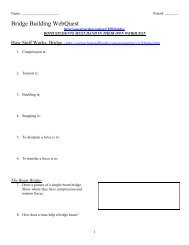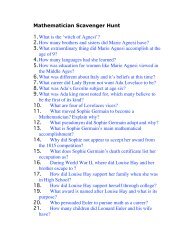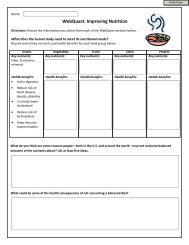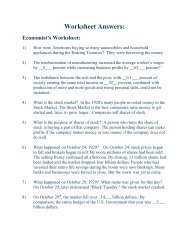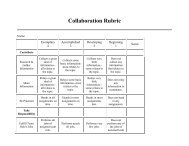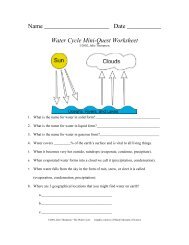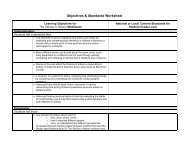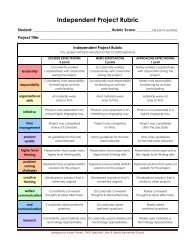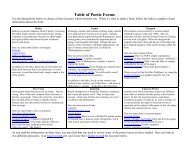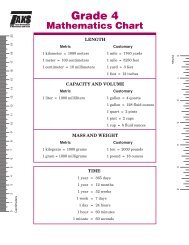Genetic Disorders Rubric - QuestGarden.com
Genetic Disorders Rubric - QuestGarden.com
Genetic Disorders Rubric - QuestGarden.com
Create successful ePaper yourself
Turn your PDF publications into a flip-book with our unique Google optimized e-Paper software.
Biology/English/Drama Cross-Curricular Project: <strong>Genetic</strong> <strong>Disorders</strong><strong>Rubric</strong>Role Play/Presentation 5 - Exceeds Standards 4 - Meets Standards 3 - Almost Meets Standards 2 - Partially Meets Standards 1 - Does Not Meet StandardsPreparednessAmount of informationOriginalitySpeechBody languageStudent is <strong>com</strong>pletely prepared andhas obviously rehearsed. Allinformation is presented frommemory. Brochure is presented anddiscussed, but student is notdependent upon it to conveyinformation.Demonstrates an exceptionalunderstanding of the geneticdisorder. Stays on topic 100% of thetime.Student is prepared and hasobviously rehearsed. Almost allinformation is presented frommemory. Brochure is presented anddiscussed, but student is notdependent upon it to conveyinformation.Demonstrates a full understanding ofthe genetic disorder. Stays on topic90-99% of the time.Interaction with "patient"Interaction with "patient"demonstrates considerable originality demonstrates originality andand inventiveness. The prognosis is inventiveness. The prognosis ispresented in a unique and interesting presented in an interesting way.way.Student speaks clearly and distinctly100% of the time in <strong>com</strong>pletesentences and mispronounces nowords. Volume is loud enough to beheard by all audience membersthroughout the presentation.Student appears relaxed andconfident, establishes eye contactwith "patient," and exhibits nodistracting body movement.Student speaks clearly and distinctlyall the time in <strong>com</strong>plete sentences80-90% of the time andmispronounces no more than oneword. Volume is loud enough to beheard by all audience members atleast 90% of the time.Student seems fairly prepared butmight have needed a few morerehearsals. Student may need torefer to the brochure to <strong>com</strong>municatethe prognosis.Demonstrates a good understandingof the genetic disorder. Stays ontopic 75-89% of the time.Interaction with "patient" shows someoriginality and inventiveness.The students is somewhat prepared,but it is clear that rehearsal waslacking. Student relies heavily on thebrochure to <strong>com</strong>municate theprognosis.Demonstrates some understandingof the genetic disorder. Stays ontopic 59-74% of the time.Interaction with "patient" shows littleattempt at originality andinventiveness.Student speaks clearly and distinctly Student mispronounces severalin <strong>com</strong>plete sentences 70-80% of the words and/or rarely speaks intime and mispronounces only 1-2 <strong>com</strong>plete sentences.words. Volume is loud enough to beheard by all audience members atleast 80% of the time.Student appears relaxed, exhibits Student appears slightlyvery little distracting body movement, un<strong>com</strong>fortable but establishes eyeand establishes eye contact with the contact with the "patient" and does"patient."not exhibit distracting bodymovement.Student does not seem at allprepared to present. Brochure isread to the "patient."Does not seem to understand thegenetic disorder very well. Project islacking several key elements andhas many inaccuracies.Interaction with "patient" shows noattempt at original thought.Student often mumbles and/or cannot be understood and/or volume isoften too soft to be heard by allaudience members.Student appears very un<strong>com</strong>fortable The student's body movements areand/or does not establish eye contact <strong>com</strong>pletely distracting.with the "patient."ComprehensionStudent is able to accurately answerall questions posed by the "patient"about the prognosis.Student is able to accurately answermost questions posed by the"patient" about the prognosis.Student is able to accurately answera few questions posed by the"patient" about the prognosis.Student is able to accurately answervery few questions posed by the"patient" about the prognosis.Student is unable to accuratelyanswer questions posed by the"patient" about the prognosis.
Biology/English/Drama Cross-Curricular Project: <strong>Genetic</strong> <strong>Disorders</strong><strong>Rubric</strong>OrganizationBrochureQuality of Information5 - Exceeds Standards 4 - Meets Standards 3 - Almost Meets Standards 2 - Partially Meets Standards 1 - Does Not Meet StandardsAll required sections are fullydeveloped using information from theresearch outline in paragraph format.Additional appropriate sections areincluded in a well-organized format.All paragraphs include anintroductory sentence, explanationsor details, and a concludingsentence.Information clearly relates to thegenetic disorder and is interestingand informative. It includes manyadditional supporting details and/orexamples using the students' ownwords.All required sections are wellorganizedand fully developed usinginformation from the research outlinein paragraph format. All paragraphsinclude an introductory sentence,explanations or details, and aconcluding sentence.Information clearly relates to thegenetic disorder. It includes manysupporting details and/or examplesusing the students' own words.All required sections are organizedand <strong>com</strong>pleted in paragraph formatusing information from theac<strong>com</strong>panying research outline.Most paragraphs include introductorysentence, explanations or details,and concluding sentence.Information clearly relates to thegenetic disorder. It provides 2-3supporting details and/or examplesusing the students' own words.Required sections are <strong>com</strong>pletedusing information from theac<strong>com</strong>panying research outline, butparagraphs were typically notconstructed well.More than two required sections aremissing and/or in<strong>com</strong>plete and/or donot use information from theresearch outline. Paragraphingstructure was not clear andsentences were not typically relatedwithin the paragraphs.Information does not clearly relate to Information has little or nothing to dothe genetic disorder. Very few details with the genetic disorder.and/or examples are given. Someinformation is not presented usingthe students' own words.MechanicsThere are no grammatical, spelling orpunctuation errors.There are almost no grammatical,spelling or punctuation errors.There are some grammatical There are several grammatical,spelling, or punctuation errors, but spelling, or punctuation errors thatthey do not interfere with the reader's interfere with the reader's<strong>com</strong>prehension.<strong>com</strong>prehension.There are many grammatical,spelling, or punctuation errors thatinterfere with the reader's<strong>com</strong>prehension.SourcesAll sources, including graphics, areaccurately documented in the WorksCited section in MLA format. Allsources documented on the list ofWorks Cited are accurately citedwithin the brochure text in MLAformat (parenthetical citations).All sources, including graphics, areaccurately documented in the WorksCited section in MLA format.All sources, including graphics, aredocumented in the Works Citedsection in MLA format with fewmistakes.All sources, including graphics, aredocumented in the Works Citedsection but there are many mistakesin MLA formatting.Not all sources are documented inthe Works Cited section.AttractivenessThe brochure has exceptionallyattractive formatting and readabletext. Graphics effectively support thetext in a balanced manner.The brochure has attractiveformatting and readable text.Graphics support the text in abalanced manner.Graphics support the text, but thereare so many that they distract fromthe text.Graphics support the text, but thereare too few and the brochure seems"text-heavy."Graphics do not support theac<strong>com</strong>panying text or appear to berandomly chosen and/or the text isunreadable.



